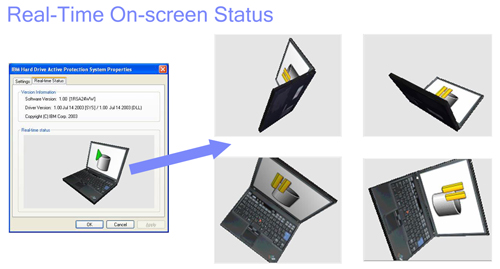
Original Link: https://www.anandtech.com/show/1173
IBM ThinkVantage Technologies: Hard Drive Active Protection System
by Andrew Ku on October 7, 2003 12:00 AM EST- Posted in
- Laptops
Profit margins are getting thinner and brand name recognition has become increasingly important to consumers when buying a system, particularly, mobile systems. For businesses, there are two main ways to go about increasing net profits: reducing production costs and/or reducing operating costs. Keep in mind that often the traditional method has been to go about slashing production costs like price per component, etc.
Of the main mobile system vendors out there, there are three main companies that have high brand name recognition: Dell, IBM, and HP/Compaq. Of the three, Dell’s brand name has been renowned for providing great technical support at anytime, but this type of availability does increase operating costs since it involves more employees at work. So what are we poking at? Well, one of the critical points in operating costs is Return Material Authorization, or as some of us have grudging become familiar with, RMA.
Dell has really been the first mobile system vendor to provide purposely users the ability to service (not upgrade) their notebooks, albeit minimally (look at the Inspiron 8600 or the Latitude D800). Most of the time, system vendors shy away from providing this ability because they figure the customer will screw something up and cause them a RMA case. Not a good thing when you are trying to keep costs down.
Whether it is reducing warranty period (something that consumers definitely don't want) or creating a better/more hearty product, reducing the number of RMA incidents is good financial news for a company. Of course, creating a better/more hearty product is the preference between the two, but companies are often willing to settle for the first, since they can’t do the second. Though, let’s face it, no one likes dealing with RMAs.
IBM Hard Drive Active Protection System
This brings us to today's topic: IBM's Hard Drive Active Protection System or HDAPS, for short. It is a feature that IBM is introducing to reduce their RMAs and increase overall customer satisfaction. According to IBM, this will be part of their ThinkVantage Technologies, which “helps make IBM personal systems less depending on IT staff or intervention for basic tasks like deployment, backup, security, and more…” (We took a look at ThinkVantage briefly in our IBM ThinkPad X31 review.) IBM's focus on their ThinkVantage Technologies is also from an 80/20 rule in which they believe and work around, where their customers care less than 20% on purchasing price when considering the total cost of ownership and the 80% is everything else (including support, security, data integrity, fast redeployment, etc.). They have really thought this cost benefit analysis through, since they even go as far as publishing their optimizing management costs white paper.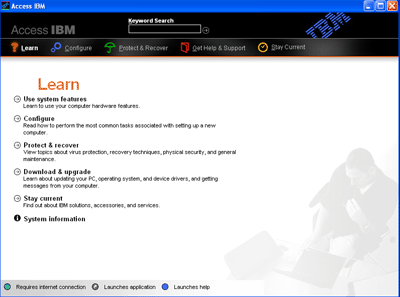
Now back to the matter at hand. IBM's Hard Drive Active Protection System, in a nutshell, is a feature that protects the laptop automatically from damage when dropped or when motion occurs, which are one of the top causes of RMAs and service requests.
Technically speaking, this features parks the hard drive head temporarily when a drop or similar damage event is predicted. Prediction is based on hardware and software components. The hardware component is comprised of a motherboard-mounted motion detector (IBM also refers to it as the “accelerometer”) that monitors movement of the notebook continuously. The software component basically receives, interprets, and reacts to signals from the motion detector. It is the software component that actually signals the hard drive to park the drive head when motion or vibration is detected.
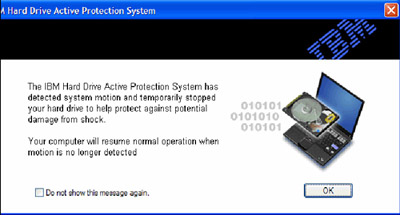
Dropping a hard drive while a hard drive is still active can result in misaligning the drive head, which in consequence, results in the inability to read and write data. More impressively, IBM says that their software can differentiate between harmful movements and repetitive motion (for example, in a train, car, or airplane).
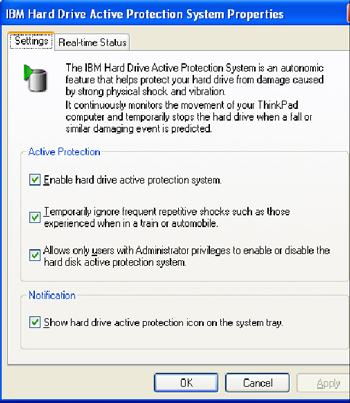
This system is user-configurable to the extent that you can mediate one or two minor features and enable or disable HDAPS. The status of the system is displayed to the user via the control panel, system tray icon, and/or the configuration applet.
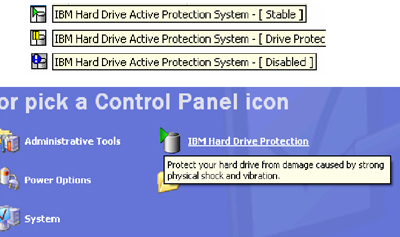
It is even more interesting to note that the IBM Hard Drive Active Protection System can monitor (and illustrate) the orientation of the notebook in real-time.
Click to enlarge.
We have yet to take a look or experience this protection system first hand, but this is something that really interests us. If the hardware component can provide orientation information, it is definitely something that we want to take an up-close look at once we get a working sample.
Conclusion
IBM tells us that the Hard Drive Active Protection System will be available on all ThinkPad R50 (pictured below) and T41 models. With the information we have on hand, it doesn't look like this feature will be included on earlier notebooks. If it was a simple software issue, IBM could simply issue a notice to upgrade all past notebooks and even those in current production. However, the Hard Drive Active Protection System is based largely on a motherboard-mounted motion sensor, which means that systems without the hardware sensor will be incompatible with the software. Refreshing designs for motherboards of current notebook systems in production would just cost a ridiculous amount of money (plus the large resources and the length of time needed to qualify the new design).Click to enlarge.
We bet that this is a feature that past IBM consumers (and other pre-existing non-IBM notebook owners) will want, and this should put another notch towards making an IBM notebook more tempting to prospective buyers. This will prove to be a more ample feature to business users, since it gives data integrity and peace of mind.As of yet, we have not heard of a similar feature that has been or will be provided on other brands of mobile systems. Overall, the concept is really simple (and some may wonder why no one thought of this before), but it will provide a large benefit to both IBM and its customers and is revolutionary in approach, thought, and concept.
So now it is waiting time; let's see if IBM can bring us a working sample soon. After we put it through the paces, it'll be interesting to see if it stays working…

